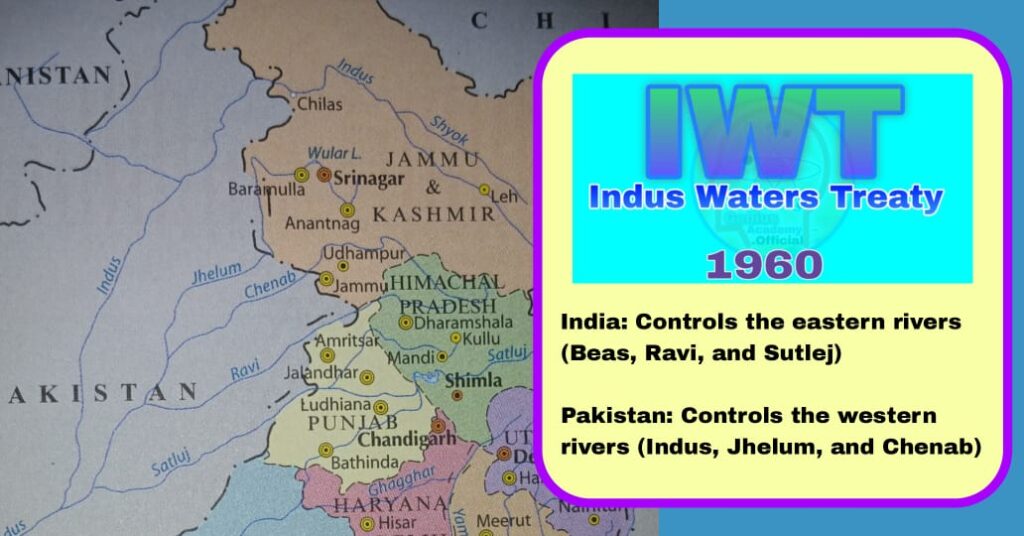
Contents
hide
Context
India has recently sought a review and modification of the Indus Waters Treaty (IWT), signaling its intention to address contemporary issues and better align the treaty’s provisions with modern challenges, including demographic pressures and environmental needs.
History and Success of the Indus Waters Treaty
- Diplomatic Achievement:— Signed in 1960, the IWT stands as a rare example of successful trans-boundary water cooperation, with India and Pakistan maintaining this agreement despite multiple conflicts, including wars and other tensions. It is considered a hallmark of diplomacy in water sharing.
- India’s Concession:— Under the treaty, 80% of the waters of the Indus River and its tributaries were allocated to Pakistan, with India granted control over the eastern rivers (Ravi, Beas, Sutlej). This has often been cited as a significant concession by India, demonstrating its commitment as a cooperative upper riparian state.
- Stability Through Crisis:— The treaty has endured even through tense periods such as the 2001 Parliament attack, the 2008 Mumbai attacks, and the more recent Uri and Pulwama incidents.
Reasons for India’s Demand for Treaty Modification
- Demographic and Environmental Pressures:— With rapid population growth and changing climatic conditions, India faces heightened water demands. This necessitates updates to the treaty’s framework to ensure sustainable water use and address new challenges, including unpredictable water flows.
- Clean Energy Goals:— India’s emphasis on developing hydropower projects aligns with its clean energy and emissions reduction goals. To fully harness its hydropower potential on the western rivers, India seeks greater operational flexibility within the treaty framework.
- Cross-Border Tensions:— Persistent tensions, particularly related to terrorism in Jammu & Kashmir, have impacted India’s capacity to utilize its allocated water resources, further straining bilateral cooperation.
- Developmental Projects and Pakistan’s Objections:— India’s “run-of-the-river” hydropower projects, such as the Ratle and Kishanganga Hydroelectric Projects (HEPs), have faced resistance from Pakistan. The current treaty lacks robust mechanisms to address such disputes comprehensively.
- Legal Provisions for Modification:— As per Article XII (3) of the IWT, the treaty can be modified through mutual consent. India’s formal notification reflects its intention to address outdated aspects of the treaty.
Disputes and Legal Challenges
- Kishanganga and Ratle HEPs:— Pakistan has consistently opposed these projects, claiming they violate the IWT’s terms regarding water flow regulation. Disputes over their operation have escalated into legal proceedings.
- Pakistan’s Legal Actions:— Pakistan initially requested a *Neutral Expert to assess the disputes but later escalated the matter to the Permanent Court of Arbitration (PCA). India, opposing the PCA’s jurisdiction, abstained from these proceedings, arguing that both mechanisms could not be activated simultaneously.
- World Bank’s Role:— The World Bank, as a mediator, suspended both processes in 2016 to foster bilateral talks. However, they were reactivated at Pakistan’s insistence in 2022.
Divergent Perspectives and Challenges
- Riparian Interests:— As an upper riparian state, India prioritizes optimal resource use for development, while Pakistan, being a lower riparian state, emphasizes the need for uninterrupted downstream flows for its water security.
- Environmental Gaps in the Treaty:— The IWT does not address evolving environmental challenges like *glacial retreat, climate variability, and changing river patterns. This poses significant issues in ensuring sustainable and predictable water flows.
Pakistan’s Concerns
- Water Scarcity:— Pakistan fears that India’s projects will lead to a reduction in water flow downstream.
- Maintenance of Flows:— Pakistan emphasizes adherence to previous arbitration rulings, such as the *2013 PCA decision, which upheld the need for uninterrupted downstream flows.
- Political Allegations:— Pakistan has accused India of using water as a political tool or “water terrorism” despite India’s adherence to treaty terms.
Proposed Modifications and Recommendations
- Equitable and Reasonable Utilisation (ERU):— The principles outlined in the *1997 UN Watercourses Convention may help address shared water challenges through a more flexible, equitable approach.
- Environmental Impact Assessments (EIA):— Instituting EIA protocols for HEPs could ensure due diligence regarding their effects on shared rivers. This approach aligns with precedents set by international legal bodies.
- Potential for Joint Projects:— The treaty’s Article VII.1(c) allows for joint engineering projects, creating a pathway for collaboration to address river variability.
- Enhanced Cooperative Mechanisms:— New Memoranda of Understanding (MoUs) and cooperative frameworks within the IWT structure could bolster dispute resolution mechanisms.
Implications of Treaty Revision
- Addressing Regional Needs:— A revised treaty could better reflect evolving regional needs, including sustainable resource-sharing, security, and development.
- Promoting Stability:— Revisiting the treaty could strengthen regional stability and foster cooperation on water issues.
Implications of India’s Potential Unilateral Withdrawal
- Regional Instability:— Withdrawal risks escalating tensions in a nuclear-armed region.
- Impact on Other States:— There could be spillover effects, influencing countries like China and Afghanistan.
- International Standing:— India’s global reputation could be impacted by any unilateral actions against established treaties.
Path Forward: Recommendations for a Sustainable Treaty
- Incorporating Environmental Flows (EF):— Aligning with global standards such as the *Brisbane Declaration to ensure river health.
- Climate Adaptation Provisions:— Integrating climate adaptation clauses to manage unpredictable water flows and bolster resilience.
- Alignment with Global Standards:— Updating the IWT in line with international frameworks, such as the *1997 UN Watercourses Convention, to address contemporary challenges.
- Optimising India’s Allocation:— Fully utilizing India’s rights over western rivers to support local development in Punjab and Rajasthan.
- Diplomatic Leverage:— Consider suspending Permanent Indus Commission (PIC) meetings to encourage serious renegotiations.
_

